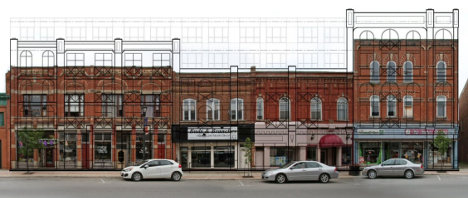By Stephen Vance, Staff

A proposed development that would significantly alter the look and feel of Meaford’s downtown core cleared a major hurdle on Monday July 27, when Meaford’s council approved zoning and official plan amendments that give the green light for increased building height, a key component of the proposed development.
Council’s unanimous approval of the increase in allowable building height, along with comments made by councillors during discussion at their July 27 meeting, also seem to pave the way for the demolition of historic brick buildings located on Sykes Street.
Before making their decision, two members of the Architectural Conservancy Ontario – Meaford (also known as Heritage Meaford) made a passionate presentation to council in hopes of convincing councillors to reject the request for taller buildings in Meaford’s downtown core, and to protect Meaford’s historic buildings.
“I would like to read you just one little section from the downtown heritage conservation district plan. This is the section that talks about the demolition of heritage buildings and structures. You all voted on this, you passed it,” ACO Meaford member John Kerr told council. “The demolition of heritage buildings and structures shall not be permitted, except in extenuating circumstances such as natural disasters, fire, floods, tornadoes, and earthquakes. I haven’t felt any earthquakes recently.”
While the proposed development has been a cause for concern in the community for several months, Meaford’s Director of Planning and Building, Rob Armstrong, told council that the plans for the development – which include tearing down four buildings on Sykes Street and replacing them with a new structure that is significantly taller, and includes underground parking – generally meet municipal planning policies. Armstrong said that the developer has agreed to preserve some of the building facades – just 16 percent according to ACO Meaford member David Baker.
While ACO Meaford stands firm in their desire to protect the historic buildings, one business owner – and resident of – one of the buildings in question, took to Facebook in the days prior to the July 27 meeting to express support for the proposed development.
“While I love our downtown, I do also wonder at what point do we all have to realize that this town is slowly dying,” posted Nancy Ellis, the owner of Simply Unique, which is located in one of the buildings proposed for demolition should the zoning amendments be approved by council. “If and when this goes through I not only lose my storefront, but also my home! The people that are so hell-bent against the BIG build should have bought these stores and invested some of their money into the buildings that are truly crumbling around us. These developers were the only ones willing to purchase these run down eye-sores. Now that they have a goal, who are we to say they can’t? They are willing to work with us…do their best to build with our input as to what the buildings will look like. Everyone who is digging in their feet YELLING NO, needs to step up and attend the meetings, learn what its all about and STOP the gossip without knowing the facts!”
Another concern that has been expressed by some residents, and was a topic of discussion for councillors on July 27, is the potential for an empty lot on Meaford’s main street for months or years to come, however Armstrong says in his report that the heritage permit process will help protect the municipality from such an outcome.
“The proponent had applied for a Heritage Permit to demolish the buildings and construct the new buildings. The intent was that Council could consider the Permit approval with the OPA/ZBA approval. Based on comments from the Peer Review Architect, this should be deferred until the proponent prepares the Conservation Plan as part of the Site Plan Approval process. In addition, the Municipality can ensure that the lands get rebuilt in a timely fashion as a condition of the Heritage Permit. Appropriate Securities will be included in the Site Plan Agreement that guarantees this requirement,” wrote Armstrong in his report.
That response doesn’t satisfy all. One resident asked what would happen should the first-time developer run out of money, or go bankrupt after the buildings have been torn down, and before the new structures have been erected – a question for which Armstrong had no answer other than that the municipality will do everything in its power to protect the community from such an outcome.
Councillor Steven Bartley asked if the members of ACO Meaford were willing to put their money where their mouths are with regard to preserving the buildings.
“I’ve been told that downtown Meaford looks old and tired. If we don’t allow this to go forward, is the heritage group going to bring the money forth to bring this up ASAP to the standards that it should be for the downtown. If they’re not, and it’s in the millions of dollars, if they’re not willing to bring this up, who will? Having said that, if it’s not brought up, it’s just going to go downhill. If somebody comes forward with that much money, I’ll back them. But if it’s not going to be fixed, it has to go down another avenue,” offered Bartley.
Meaford Mayor Barb Clumpus told her fellow council members that she is pleased that the developer is willing to tailor his plans to accommodate the preservation of at least parts of the buildings, and she said that the developer is also planning to pay homage to the historic structures by building the new structure with similar looking facades.
“This is an emotional issue, preserving heritage. I’m a newcomer to this area, relatively so,” Clumpus told council before joining her fellow councillors in a unanimous vote in favour of the amendments. “But I have to say, what spoke to me in looking at this area was the spirit that this small town Ontario architecture spoke to. It was certainly very evident to me that it was more than bricks and mortar, it was not just the facades that were there, it was the ambiance of the whole small-town, downtown area.”












